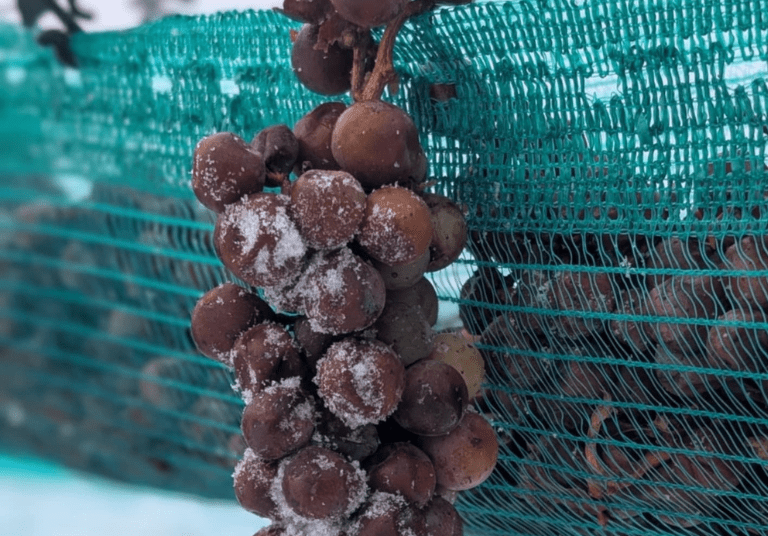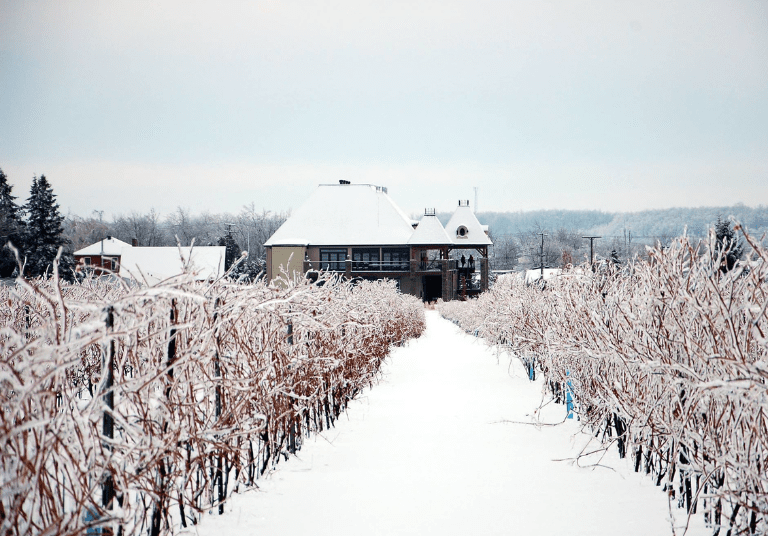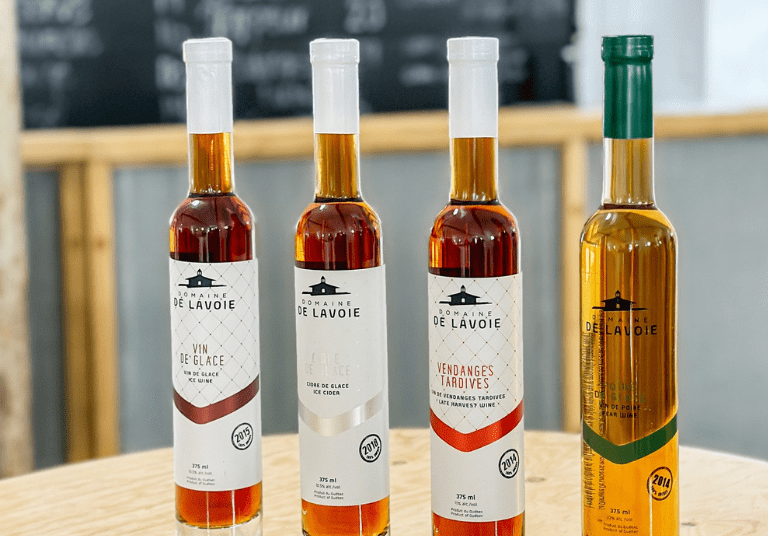Ice wine: history, production, and how to taste it
Say hello to the king of the Quebec table: Ice Wine! This sweet little gem is produced thanks to winter’s magic, patient winemakers, and grapes brave (or reckless) enough to endure fall and the start of winter outdoors. The result: a golden, velvety wine that manages the feat of being both sweet and refreshing on the palate. 😋🍷

The history of ice wine
Grape growing in Quebec isn’t new: it’s mentioned as far back as the New France era, though it was mostly on a small experimental scale back then. 🍇
In 1973, in British Columbia, a German immigrant named Walter Heinle created an ice wine inspired by his homeland. Production then took off in Ontario, and the “icewine” trend was on its way! Quebec joined the adventure in 1994, led by winemaker Jean Joly from Vignoble du Marathonien in Montérégie, who pioneered the craft. Today, he remains a leading figure in the field, and his products have won numerous awards.
Since then, Canada has become the world’s largest producer of ice wine, with Quebec ranking third in Canada! 🥉
How is it made in Quebec?
To make ice wine, you first need grapes with a solid constitution. The favorite in Quebec? The hardy Vidal, which retains its freshness even when it spends a bit too long outdoors at -10°C. Several steps are then required to produce ice wine. ⏳
The netting process
In Quebec, the renowned “mise en filet” (netting) technique is key. As the name suggests, the grape clusters are literally placed in a net so they can continue to dry (and sweeten) in the open air, while staying safe from hungry birds. 🐦
This process generally takes place after the first frost, in November. The vines undergo a pre-pruning, then the nets are set and filled with the clusters. Finally, the vine is protected from the cold by mounding soil around it or covering it with tarps.
Harvest and pressing… at the right moment!
When the thermometer reads between -8°C and -12°C, it’s time to harvest at night or at dawn (sometimes in the snow 🌨️). The grapes must be pressed immediately while still frozen: that’s cryoextraction. The water remains in ice form and doesn’t flow out, while the sweet juice (the must) slowly runs off.
💡 Did you know? 💡
🔹During the sugar concentration process, grapes lose 40% to 70% of their juice.
🔹In wine production, 100 kg of grapes yield between 70 and 75 liters of must.
🔹In ice wine production, that same amount of grapes yields only 14 to 17 liters.

IGP Vin de glace du Québec
Since 2014, Quebec has its very own IGP Vin de glace du Québec (Protected Geographical Indication for Quebec Ice Wine). To earn the official seal, a winemaker must adhere to a strict set of specifications. 🖊️ 📖 Here are a few requirements:
- Both white or red grape varieties may be used, except for pure Vitis labrusca varieties.
- The grapes must be grown manually in Quebec, within the appellation area*, and must have naturally frozen on the vine.
- The must must have a sugar content of at least 32°Brix at each pressing, and at least 35°Brix in the tank before fermentation.
- The wine must be vinified, bottled, and labeled at the vineyard itself.
- The alcohol level must range from 7% to 14.9% by volume.
- And more!
*The appellation area is defined by three carefully calculated agroclimatic indices: the number of frost-free days (at least 150), the cumulative growing-degree days (minimum of 900), and a winter temperature that does not drop below -35°C (otherwise the vines won’t survive! ❄️). This has led to defining a zone along the Saint Lawrence River stretching to Île d’Orléans and extending all the way to the Ontario border to the west, and the U.S. border to the east.
In short, you need a summer that’s warm enough for the grapes to grow and a winter that’s cold enough to turn them into little balls of concentrated sugar!
Once the precious liquid is bottled, it undergoes an independent laboratory test and a tasting by an approval committee. All of this ensures you’re getting real Quebec ice wine with a distinctly local flavor! 🩵
How to properly taste it (and impress your friends)
a) Characteristics
- 🎨 Color: Golden yellow, sometimes amber, with a syrupy texture.
- 👃 Aroma (Nose): Tropical fruit, honey, lychee, caramel… sure to transport your imagination down south while it’s -15°C outside.
- 👄 Taste: A sweet first impression, followed by bright acidity for perfect balance.
b) Pairings
It’s recommended to enjoy it alongside a light dessert (fruit-based, for example), foie gras, or even cheese. The creamier, the better! 🍰 🧀
c) Serving tips
- Ideal temperature: Around 8°C. Keep it well chilled in the fridge until ready to serve, and put it back in between servings.
- Glassware: A white wine glass is perfect. Forget the tiny glass—ice wine needs room to let its aromas shine.
- Serving size: Pour small amounts (1 to 1.5 oz) so it stays nice and cool.

In conclusion, winter has never tasted so good!
Quebec Ice Wine, a pure product of winter, is delightfully sweet and perfectly balanced by a refreshing acidity. Behind this little miracle in a bottle lies patient know-how, cool nights, a generous dose of passion, and of course, strict regulations to ensure you truly taste the winter spirit of our terroir. ☃️ 🩵
One thing’s for sure: the next time we complain about the cold, we’ll remember that these temperatures also help maintain our expertise and create a delicious, joyfully frosty Quebec specialty.
Cheers! 🥂
To discover local vineyards, check out our repertory. 📖
Sources :
CARTV https://cartv.gouv.qc.ca/appellations-et-termes-valorisants/appellations-reconnues/repertoire/vin-de-glace-du-quebec/
IGP Vin de glace du Québec https://cervides.ca/wp-content/uploads/2022/04/vin-de-glace-brochure-2022-finale.pdf







